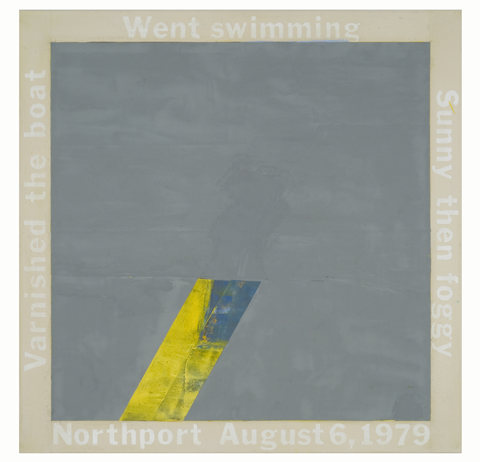 ‘Aug.6 (Pier)’ oil on canvas, 30 by 30 inches, 2013, by Joshua Ferry |
Nobody quite believed Paul Delaroche’s 1839 pronouncement upon first seeing a daguerreotype. Painting has not really had to fight an existential struggle, but it has had to argue for its continued relevance and intrinsic difference from other artistic media. What makes painting so special? In Maine this seems a superfluous question, seeing how much painting is out there.
But there’s painting and there’s painting. Some of it uses the medium not to depict something seen or imagined, but to see how far it can leave representation behind and still function in a similar way. Tom Hall currently shows work at the June Fitzpatrick Gallery and Joshua Ferry at Art House Picture Frames. The only thing these two artists share—and this is a big thing—is their belief in, and their ability to convince us of, the power of painting. The power of painting to surprise us, to nudge our imagination, to suggest what is not there. All there is is paint. And a world at the same time.
Hall’s paintings range widely in size and continue his exploration of darkly atmospheric landscapes, which he gives a deliberate contemporary twist. While walking on them leaving footprints seems a rather facile strategy, interesting, disrupting effects are achieved by the incorporation of old or antiqued newspaper and book pages and selective application of varnish. This material subversion coexists with a historicism that harks back to tonalist painters like George Inness.
In some of Hall’s images the reduction of landscape to horizontal bands of ground, trees, and sky can become borderline formulaic. However, further reduction to the point of near obscurity yields what I consider some of his strongest and paradoxically richest work to date. Suggesting links to both James McNeill Whistler and Ad Reinhardt, “Nocturne–Fort Gorges 1” nearly obliterates its subject in encroaching blackness. The difference between matte and glossy defines the fort and its nocturnal reflection, making surface details as much image-generative as any application of color. At his best, Hall continues to produce powerful images that make us question what fundamentally it is we actually see in them.
Ferry’s seven paintings and one drawing go into several directions. Most successful are three paintings inspired by a journal written by the artist’s brother at age eleven. Each square canvas is inscribed around its perimeter with an entry of what a child may find memorable, like painting a boat or a passing oil tanker. The center of each work is occupied by, for Ferry, surprisingly freely applied fields of color. Although their surfaces are rich with incident, alone these would have a hard time holding up. In combination with the writing, however, the works intriguingly highlight the process from inspiration over time-bound execution to final work. At the same time, they trigger complex associations between language and art.
An event, captured through language, gives rise to non-verbal imagination. In effect, writing acts as physical and conceptual frame, as a stage set for the painting to perform its drama. “Aug. 6 (Pier)” is governed by a correlation between atmosphere (“sunny” and then “foggy”), activity, form, and color. A diagonal swath of yellow and blue juts into the gray swallowing everything else. Only very little evidence of previous layers of color remains.